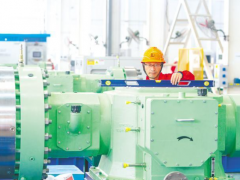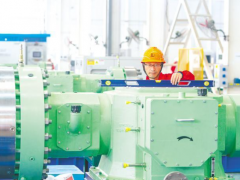据钻机地带6月13日报道,近日,全球研究和咨询公司伍德麦肯兹(Wood Mackenzie)表示,到2050年,全球炼油行业的低碳氢需求可能达到5000万吨/年。
炼油领域是氢能应用最大的市场之一,2020年约占3200万吨/年,占全球氢需求的30%~35%。氢处理和氢裂解化是炼油行业消耗超90%氢气的主要炼油工艺,分别用于减少成品中的硫含量和提高运输燃料的产量。
然而,炼油过程中65%以上的氢需求是由催化重整和乙烯裂解副产品提供的氢来满足;这不太可能被低碳氢气所取代。任何氢短缺都可以通过气基蒸汽甲烷重整和煤炭目的性生产来解决,这两种方式合计约占炼油厂氢需求的32%。
伍德麦肯兹研究总监古普塔表示,如果低碳氢具有成本竞争力,并且随着时间的推移政策支持不断发展,低碳氢有可能取代专用氢作为原料。到2050年,该领域低碳氢的潜在全球市场规模可能达到1000万吨/年,从而使全球范围1和范围2的炼油厂碳排放量减少10%或1亿吨/年。他补充道,但真正的改变者是在燃烧应用中替代化石燃料来产生热量和蒸汽。这将为炼油中的低碳氢提供更大的市场,到2050年,潜在市场规模将达到4000万吨/年,碳排放量减少高达3亿吨/年,约25%。因此,到2050年,炼油行业对低碳氢的潜在总需求可能高达5000万吨/年。
为了进一步脱碳,炼油商将不得不考虑更多的低碳技术,如电加热、碳、主要碳排放设施的捕获和存储以及生物质气化。炼油企业将不得不采用可再生能源,使用低碳原料和产品。这些解决方案的组合需要解决这个复杂的问题。
为了使低碳氢与专用的化石燃料氢具有竞争力,需要降低成本和高碳价。成本很重要,因为氢气生产占炼油厂可变运营成本的10%~25%。此外,高碳价和相关的排放惩罚可能成为从化石燃料氢转向低碳氢的主要驱动力。
在当前天然气/液化天然气价格居高不下且波动剧烈的情况下,以及地缘政治冲突之后,绿色氢比基于化石燃料的灰色氢便宜。因此,有市场机会使氢供应来源多样化,以减少排放并支持能源安全。
在燃烧应用的情况下,更高的热值和更低的排放使低碳氢成为有吸引力的替代品。尽管燃烧提供了更大的市场,但低碳氢需要实现更低的成本,或者需要更高的碳价格才能在燃烧领域竞争,而不是与专用氢竞争。
假设大宗商品价格恢复到受长期基本面因素驱动的水平,到本世纪30年代初,要使低碳氢在炼油燃烧领域具有竞争力,需要将碳价格提高到100美元/吨至150美元/吨。另外,从长远来看,绿色氢的成本必须低于每公斤1.5美元,才能与天然气和燃油的燃烧相竞争。
除了低碳氢的成本下降,更高的碳价格、财政激励和更有力的政策支持将是加速炼油行业采用的必要条件。国家专门的氢规划将有助于提高低碳氢在许多行业的渗透率。
Gupta表示,从成本和排放的角度来看,从长远来看,炼油更可能向绿色氢而非蓝色氢迈进。然而,拥有低成本天然气资源和碳封存能力的国家将有机会进入蓝色氢气市场。低碳氢的替代经济很大程度上依赖于煤炭、天然气、碳和可再生能源的价格,因此炼油厂和国家的具体应用场景要非常具体。
郝芬 译自 钻机地带
原文如下:
Low-Carbon Hydrogen Demand Could Reach 50 Mtpa By 2050
Potential low-carbon hydrogen demand from the global refining sector could reach 50 million tons per annum by 2050, says global research and consultancy group Wood Mackenzie.
Oil refining is one of the largest markets for hydrogen, accounting for about 32 Mtpa or 30-35% of global hydrogen demand in 2020. Hydrotreating and hydrocracking are the major refinery processes consuming over 90% of hydrogen in the refining sector, and they are used to reduce sulfur from finished products, and to increase yield of transport fuels, respectively.
However, more than 65% of hydrogen demand in refining is met by hydrogen supplied as a by-product from catalytic reformers and ethylene crackers; this is unlikely to be replaced by low-carbon hydrogen. Any hydrogen shortfall is met by on-purpose production from gas-based steam methane reforming and coal, together accounting for about 32% of refinery hydrogen demand.
“Low-carbon hydrogen has the potential to replace on-purpose hydrogen as a feedstock if low-carbon hydrogen becomes cost competitive and policy support develops over time. Potential global market size for low-carbon hydrogen in this segment could be up to 10 Mtpa by 2050 delivering a 10% or 100 Mtpa reduction in overall scope 1 and 2 global refinery carbon emissions,” Wood Mackenzie research director Sushant Gupta said.
“But the real game-changer is in replacing fossil fuels in combustion applications to generate heat and steam. This will provide a larger market for low-carbon hydrogen in refining with potential market size reaching up to 40 Mtpa by 2050, and up to 300 Mtpa or about 25% reduction in carbon emissions. As such, total potential demand for low-carbon hydrogen in refining could be up to 50 Mtpa by 2050,” he added.
For further decarbonization, refiners will have to consider additional low-carbon technologies such as electric heating, carbon, capture and storage on main carbon emitting units and biomass gasification. Refiners will have to deploy renewable power and use low-carbon feedstocks and products. A combination of these solutions is required to solve this complex problem.
Both lower costs and high carbon prices are needed to make low-carbon hydrogen competitive to on-purpose fossil fuel-based hydrogen. Cost is important because hydrogen production is responsible for between 10% and 25% of refiners’ variable opex. In addition, a high carbon price and related emissions penalty could become the main driver of shifting away from fossil fuel-based hydrogen to low-carbon hydrogen.
At current high and volatile gas/LNG prices and in the aftermath of the war, green hydrogen is cheaper than fossil fuel-based grey hydrogen. So, there is market opportunity to diversify hydrogen supply sources to reduce emissions and support energy security.
In the case of combustion applications, higher heating value and lower emissions make low-carbon hydrogen an attractive alternative. Although combustion provides a bigger market, low-carbon hydrogen needs to achieve a much lower cost, or a much higher carbon price is needed to compete in the combustion sector than that required to compete with on-purpose hydrogen.
A much higher carbon price of $100/t to $150/t would be required in the early 2030s to make low-carbon hydrogen compete in the refinery combustion sector, assuming commodity prices return to levels driven by long-term fundamentals. Alternatively, green hydrogen cost must be sub-$1.50 per kilogram to compete with gas and fuel oil combustion in the longer term.
“In addition to falling costs for low-carbon hydrogen, higher carbon prices, financial incentives and stronger policy support will be necessary to accelerate adoption by the refining sector. Dedicated country hydrogen roadmaps will help grow low-carbon hydrogen’s penetration across many sectors.
“From costs and emissions perspective, a leap towards green hydrogen rather than blue is more likely in refining in the longer term. However, countries with low-cost gas resources and CO2 sequestration capacity will have the opportunity to enter the blue hydrogen market. Replacement economics for low-carbon hydrogen is hugely dependent upon coal, gas, carbon, and renewable power prices and hence, very refinery site and country specific,” Gupta said.
免责声明:本网转载自其它媒体的文章及图片,目的在于弘扬石化精神,传递更多石化信息,宣传国家石化产业政策,展示国家石化产业形象,参与国际石化产业舆论竞争,提高国际石化产业话语权,并不代表本网赞同其观点和对其真实性负责,在此我们谨向原作者和原媒体致以崇高敬意。如果您认为本站文章及图片侵犯了您的版权,请与我们联系,我们将第一时间删除。







